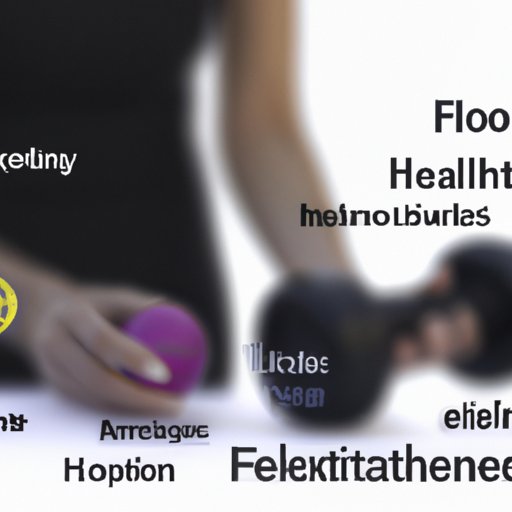Introduction
The question of how many times a week you should work out is one that is often asked by those who are looking to get into shape and improve their overall health and fitness. Although it can be difficult to know the answer to this question, there are certain guidelines that can help you find the right balance between working out too little and too much.

Outlining the Benefits of Working Out at Least Once a Week
Regular exercise has been proven to have numerous physical and mental health benefits. Working out at least once a week can help improve your physical health, increase your mental clarity and focus, and reduce stress levels.
According to a study published in the American Journal of Preventive Medicine, regular exercise is associated with a lower risk of death from all causes, as well as a reduced risk of cardiovascular disease, type 2 diabetes, and some types of cancer. The study also found that even moderate amounts of physical activity can result in significant health benefits.
In addition to physical health benefits, regular exercise can also improve your mental health. A study published in Frontiers in Psychology found that exercise can reduce symptoms of depression and anxiety, and improve cognitive function. Regular exercise has also been shown to improve sleep quality, which can further enhance mental clarity and focus.
Finally, exercise can help reduce stress levels. A study published in the Journal of Behavioral Medicine found that regular exercise can significantly reduce stress in both the short-term and long-term. This can lead to improved mood, enhanced productivity, and better overall wellbeing.
Exploring the Different Types of Workouts and How Often You Should Do Them
There are many different types of workouts that you can do, and each type has its own set of benefits and recommended frequency. Below, we will explore the different types of workouts and how often you should do them in order to get the most out of your workout routine.
Cardio Workouts
Cardio workouts are any type of exercise that raises your heart rate and gets your blood pumping. Examples include running, cycling, swimming, and walking. These types of workouts are great for improving your cardiovascular health, burning calories, and increasing your endurance.
The American Heart Association recommends doing at least 150 minutes of moderate-intensity aerobic activity per week, or 75 minutes of vigorous-intensity activity. Additionally, they suggest incorporating muscle-strengthening activities at least two days per week.
Strength Training
Strength training is any type of exercise that involves lifting weights or using resistance bands. It is great for building muscle, improving bone density, and increasing strength and power. According to the American College of Sports Medicine, adults should do strength training at least two days per week.
High-Intensity Interval Training (HIIT)
High-intensity interval training (HIIT) is a type of exercise that involves alternating periods of intense activity with periods of rest. It is great for burning calories and improving aerobic capacity. The American Council on Exercise recommends doing HIIT workouts two to three times per week.
Flexibility Training
Flexibility training is any type of exercise that helps improve range of motion and reduce stiffness. Examples include yoga and stretching. The American Council on Exercise recommends incorporating flexibility training into your workout routine at least two to three times per week.

Examining the Health Risks Associated with Not Working Out Enough
If you don’t work out enough, you may be putting your health at risk. Not getting enough physical activity can lead to weight gain, reduced immunity, and decreased energy levels.
A study published in the British Journal of Sports Medicine found that people who do not get enough physical activity are more likely to be overweight and obese. Being overweight or obese can increase the risk of developing chronic diseases such as type 2 diabetes and heart disease.
Not getting enough physical activity can also weaken your immune system. A study published in the Journal of Applied Physiology found that regular exercise can help strengthen your immune system and protect against infection and illness.
Finally, not getting enough physical activity can lead to decreased energy levels. A study published in the International Journal of Environmental Research and Public Health found that regular exercise can help increase energy levels and improve overall wellbeing.
Investigating the Optimal Frequency for Working Out to Achieve Your Fitness Goals
When it comes to working out, the key is finding the right balance between working out too little and too much. The “minimum effective dose” approach is a good way to ensure that you are getting the most out of your workouts without overdoing it.
The “minimum effective dose” approach involves doing just enough exercise to achieve your goals without overtraining. In other words, it is important to find the optimal frequency for working out that will provide the best results without putting extra strain on your body.
It is also important to personalize your workout plan. Everyone’s body is different, and what works for one person may not work for another. If you are unsure of how often you should be working out, it is best to consult a doctor or a certified personal trainer.

Analyzing the Impact of Working Out Too Much on Your Body and Mind
Although working out is important for maintaining good physical and mental health, it is possible to overdo it. Working out too much can put extra strain on your body and lead to muscle soreness, fatigue, and an increased risk of injury.
A study published in the Journal of Strength and Conditioning Research found that overtraining can lead to decreased performance, increased fatigue, and impaired recovery. Additionally, overtraining can increase the risk of injury due to muscular imbalances and poor form.
Overtraining can also have a negative impact on your mental health. A study published in the European Journal of Sport Science found that overtraining can lead to feelings of burnout, fatigue, and decreased motivation.
Conclusion
In conclusion, it is important to find the right balance between working out too little and too much. Working out at least once a week can help improve your physical and mental health, but it is important to find the optimal frequency for achieving your fitness goals without putting extra strain on your body. Different types of workouts have different recommended frequencies, and it is important to personalize your workout plan in order to get the most out of your workouts.
By following the guidelines outlined in this article, you can ensure that you are getting the most out of your workouts without risking your health or wellbeing. Remember: the key is finding the right balance between working out too little and too much.
(Note: Is this article not meeting your expectations? Do you have knowledge or insights to share? Unlock new opportunities and expand your reach by joining our authors team. Click Registration to join us and share your expertise with our readers.)
